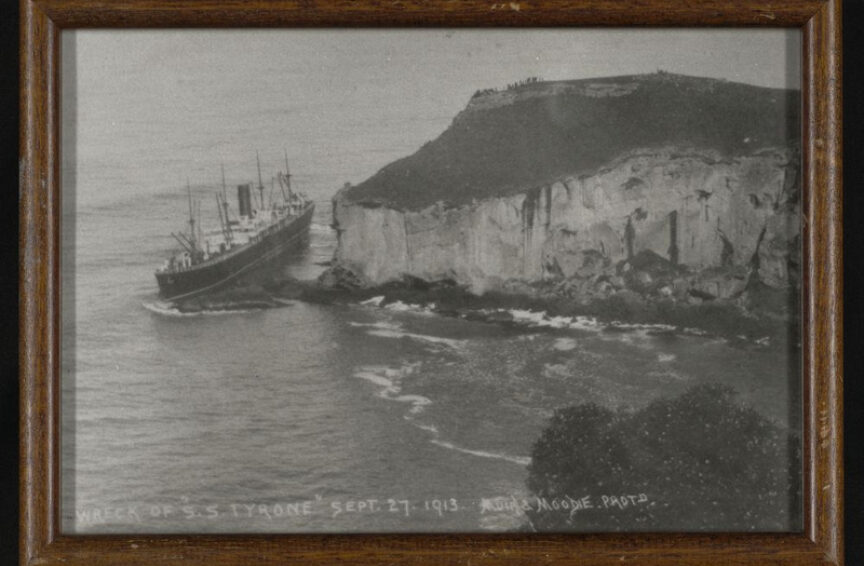PO Box 95
Lyttelton 8841
Te Ūaka recognises Te Hapū o Ngāti Wheke as Mana Whenua and Mana Moana for Te Whakaraupō / Lyttelton Harbour.
Celebrating a Port Icon – The Lyttelton Tug
Tuesday 25 October marks the 115th anniversary of the signing of the Certificate of British Registry form, passing ownership of the steam tug Lyttelton (called Canterbury at the time of her arrival) from her makers, Ferguson Brothers of Newark shipyard in Glasgow, to the Lyttelton Harbour Board. The vessel had arrived in Ōhinehou Lyttelton on September 10th 1907 after a 69 day journey under her own steam via the recently completed Suez Canal, bunkering with coal at numerous ports on her journey.
The new tug had been commissioned by the Lyttelton Harbour Board to specifications by engineer Cyrus Williams, to replace an older paddle steam tug called the Lyttelton. At just 78 gross tonnes and 80 horsepower, the paddle steamer had outlived its usefulness because cargo and passenger ships, notably the Gothic, Athenic and Corinthic, were larger than earlier vessels. The superseded paddle steamer sailed to Auckland in 1907 to serve as a ferry in Devonport until the 1940s.
The much admired new tug arrived with the title Canterbury – a name change to Lyttelton in 1911 enabled her to be distinguished from a new suction dredge also called Canterbury, which was acquired by the Harbour Board in 1912. The beautiful brass ship's bell on the wheelhouse of the Lyttelton bears her original name. This strong and manoeuvrable steel twin screw vessel of 300 gross tonnes and 38 m length was regarded as the finest tug in New Zealand at the time.
During a trial sailing in Lyttelton Harbour on 18 September, laden with dignitaries, it was noted due to a slight swell “that she would be a rather lively boat in heavy seas”; she was nevertheless regarded as “the very thing required for an up to date port” and that the £14,500 cost was money well spent.
Probably the tug Lyttelton's greatest claim to fame was acting as escort to Shackleton's Nimrod which departed for Antarctica on 1 January 1908, watched by enthusiastic crowds estimated to be up to 50,000 strong. At the time, the population of Christchurch was under 70,000 (the Census of 1906 recorded 67,878 residents of Christchurch), so that was a huge proportion in attendance. Alongside her ship-handling duties, she also performed important roles as pilot boat and fireboat over the years.
From 1939, with the arrival of a new tug called Lyttelton II, the original steam tug Lyttelton was straightforwardly referred to by port workers as Tug One, with the new arrival being Tug Two. The new tug was a 303 gross tonne, forced draught or twin triple expansion vessel, built by Lobnitz and Co of Renfrew on the River Clyde in Scotland. The two tugs served side by side for several decades; Lyttelton II was sold to a Sydney preservation group in 1981; unfortunately this did not save her from the fate of demolition in Geelong in 2006.
Lyttelton (Tug One) had yet another name change during WWII; as HMNZS Lyttelton she was fitted with a cannon and machine gun under the auspices of the Royal New Zealand Navy. Her war service was quiet and she returned to commercial work in 1944, continuing to serve vessels in port until 1970. In 1971, with the arrival of the port's first motor tug, the Canterbury, the grand old lady was retired from service.
Seriously corroded and at real risk of being scrapped, a group of skilled and enthusiastic volunteers ensured her preservation by establishing the Tug Lyttelton Preservation Society in 1973. Through countless hours of volunteer work over the decades since, this dedicated group is still responsible for her welfare. They have recently been successful in obtaining a Christchurch City Council Heritage Grant of $58,000, a good portion of the $116,000 required to install new equipment to heat the boiler electrically. It takes two days to achieve the required temperature and pressure for sailing using coal; by using electricity to preheat the boiler the tug’s coal usage will be reduced by 60%. She will still use coal whilst sailing.
Since being run as a passenger steamer the Lyttelton has hosted many weddings, work events and other functions and has a public cruise most Sundays during the summer season. As the oldest operational steamship in New Zealand, with shining brass, an elegant saloon, the fiery stokehold and rhythmic pistons in the engine room, she is an important working veteran of the steam era. On board you can witness the skilled art of the stoker, the engineers, the master and crew, as they undertake the complex process of sailing this historic vessel.
Your support of the Tug Lyttelton Preservation Society will ensure her continued sea worthy future. Thanks to these dedicated people, she has not yet “Finished with Engines” – the call from the bridge for engineers to shut off the steam.
https://www.facebook.com/tuglyttelton/
See also Tolerton, N, Lyttelton Icon 100 Years of the Steam Tug Lyttelton, 2006, Willson Scott Publishing.

